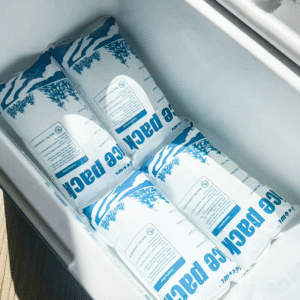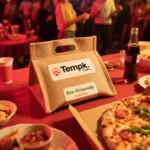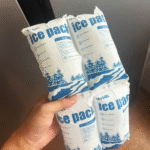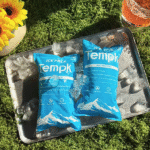How to Pack Frozen Food with Dry Ice—2025 Playbook
If you need a proven, konforme Möglichkeit, Tiefkühlware zu versenden, here’s how to pack frozen food with dry ice the right way. Verwenden Sie 5–10 Pfund pro 24 hours plus a 24‑hour buffer, surround—not touch—the product, die Schachtel entlüften, und markieren Sie UN 1845 with net kg on one surface. You’ll get fewer melt events and faster carrier acceptance.
-
Wie viel Trockeneis brauchen Sie wie man Tiefkühlkost mit Trockeneis verpackt?
-
How to apply UN 1845 labels and documents when you pack frozen food with dry ice?
-
Which insulated shipper cuts dry ice use for wie man Tiefkühlkost mit Trockeneis verpackt?
-
How do VIP panels and PCMs improve wie man Tiefkühlkost mit Trockeneis verpackt auf langen Wegen?
How to pack frozen food with dry ice, Schritt für Schritt?
Vorfrei, isolieren, surround with dry ice, Entlüftung, und Etikett. Freeze items to 0°F (–18°C), use a rigid carton with a 1.5–2 inch foam or VIP liner, place the payload in the center, put dry ice above and around it, leave vents unobstructed, and print “UN 1845, Trockeneis, net __ kg” with a Class 9 Etikett. Add a 24‑hour buffer of dry ice for delays.
Vented means CO₂ can escape as the ice sublimes; airtight seals risk pressure and damage. Insulated means EPS, Pu, or VIP panels that slow heat gain so your dry ice lasts longer. On hot routes, thicker liners (1.5–2 inch) or VIP shippers reduce burn‑off and claims. This pack‑out is repeatable, easy to train, and accepted by major carriers in 2025.
Dry‑ice “sandwich” layering for even hold time
Build layers: a base of wrapped blocks, payload centered, pellets on sides, and a top layer to counter roof heat. Separate dry ice from food with corrugate or bubble sheet to prevent cold shock. Heavier blocks last longer; pellets fill gaps to eliminate warm air pockets. Leave engineered vent holes clear and avoid sealing the inner liner airtight.
| Pack‑out step | What to add | Warum ist es wichtig | Für dich |
|---|---|---|---|
| Basisschicht | Wrapped blocks | Stabilizes floor temp | Längere Haltezeit, weniger Hotspots |
| Center load | Product in middle | Cold surrounds payload | Uniform freezing on arrival |
| Side & top fill | Pellets/blocks | Counters lid heat leak | Lower thaw risk on delays |
Actionable tips and suggestions
-
Summer lane: Use thicker liners or VIP and add 20–30% dry ice.
-
Crowded box: Fill voids with paper to cut convection.
-
Wochenendrisiko: Add a 24‑hour buffer and avoid Friday departures.
Real -World -Fall: A seafood brand upgraded to a 1.5‑inch EPS liner and added a 24‑hour buffer on summer routes; melt events dropped by about forty percent without more damage claims.
-
Erinnern: your SOP for wie man Tiefkühlkost mit Trockeneis verpackt should be documented and trained across teams.
-
If a lane is volatile, double‑check the estimator before you decide wie man Tiefkühlkost mit Trockeneis verpackt for that week.
-
Use logger data to refine wie man Tiefkühlkost mit Trockeneis verpackt on each route season by season.
How much dry ice do you need for how to pack frozen food with dry ice?
Plan 5–10 lb pro 24 Stunden in einem gut isolierten Transporter, Dann fügen Sie einen Puffer hinzu. Der Preis hängt von der Isolierung ab, Umgebungswärme, and fill ratio. Convert and mark net dry‑ice in kilograms on the box. Für Gefrierschränke, ~50 lb can hold an 18‑cu‑ft unit for two days.
To keep the math simple, fangen Sie an 7.5 Pfund pro 24 hours and adjust. Use more for thinner foam and hot routes, weniger für VIP. Always round up before weekends or customs, and test once with a data logger before scaling.
| Szenario | Isolierung | Trockeneis (lb) | Was es bedeutet |
|---|---|---|---|
| Small ≤10 lb payload, 24 H | 1.5 in EPS | 5–8 lb | Overnight meal kits |
| Medium 10–20 lb, 48 H | 2 in PU/EPS | 12–18 lb | Cross‑country food |
| Large 20–35 lb, 72 H | VIP | 12–20 lb | Hot climates/long lanes |
Practical notes
-
Use blocks at the base and pellets to fill gaps; blocks sublimate slower.
-
Always convert to kilograms for the label (kg = lb × 0.4536).
-
Run one test with a data logger before scaling SOPs.
This estimator gives you a conservative starting point for wie man Tiefkühlkost mit Trockeneis verpackt on any lane.
How to label UN 1845 correctly when you pack frozen food with dry ice?
Drucken Sie „Trockeneis“ oder „Kohlendioxid“., solide," UND 1845, and net dry‑ice kg on one surface with a Class 9 Etikett. Use the IATA acceptance checklist; most shippers do not need a DG declaration when dry ice is the only refrigerant for non‑DG goods. Passenger/cargo air follows PI 954; Kappe ist 200 kg pro Paket, and venting is required.
FedEx specifies minimum character heights: 6–12 mm depending on package capacity. Auf dem Luftfrachtbrief, include UN 1845, Eigenname, Paketzahl, und Netz kg. USPS domestic air mail allows only up to 5 lb per mailpiece and prohibits international dry‑ice mail, so integrator services are the practical route for food.
| Element | Was soll gedruckt werden? | Zweck | Nutzen |
|---|---|---|---|
| Richtiger Versandname | „Trockeneis/Kohlendioxid, solide" | Identifies hazard | Fewer counter rejections |
| UN -Nummer | Und 1845 | Global identifier | Schnelle Akzeptanz |
| Netzmasse | Nur kg | Ops planning | Avoid relabel fees |
Copy‑paste text for AWB “Nature and Quantity of Goods”
Which shipper works best for how to pack frozen food with dry ice?
Rigid outer box + EPS/PU (1.5–2 in) for 24–72 h; VIP for multiday or high‑value lanes. Upgrade insulation before piling on more dry ice—it’s often cheaper and lighter.
Standard foam is cost‑effective for domestic 1–2 days. Thicker liners give extra margin for 2–3 days. VIP shippers paired with PCMs (Phase -Klopfen -Materialien) smooth temperature swings and cut dry‑ice mass on hot routes.
| Versendertyp | Typische Mauer | Typische Dauer | Für dich |
|---|---|---|---|
| Versandkarton aus EPS-Schaum | 1–1,5 in | 24–48 h | Budget option; higher dry‑ice use |
| EPS/PU thick liner | 1.5–2 in | 48–72 h | Lower risk on warm lanes |
| VIP -Versender | Thin VIP | 96–240 h | Lowest ice mass; wiederverwendbar |
When to combine PCMs with dry ice
-
Use a −21°C PCM layer between the lid and product to damp temperature spikes.
-
Pre‑condition PCMs to their setpoint; never place PCMs directly against unwrapped food.
Extra tips for success
-
Short routes: Für wie man Tiefkühlkost mit Trockeneis verpackt An <24 h lanes, focus on tight packing over extra ice.
-
Hot weather: When you plan wie man Tiefkühlkost mit Trockeneis verpackt Im Sommer, add 20–30% mass and upgrade insulation.
-
High‑value payloads: Für wie man Tiefkühlkost mit Trockeneis verpackt with premium items, Wählen Sie VIP + logger for proof.
How to pack frozen food with dry ice for FedEx, UPS, und USPS?
All require vented packaging and UN 1845 mit Netto-kg; Klasse 9 label is mandatory. FedEx publishes marking sizes and AWB entries; UPS mirrors UN 1845 and venting notes. USPS domestic air mail caps at 5 LB Trockeneis; International ist verboten.
Readiness self‑check
-
My plan for how to pack frozen food with dry ice includes a vented shipper.
-
I calculated 5–10 lb/24 h for how to pack frozen food with dry ice, then added a buffer.
-
My labels for how to pack frozen food with dry ice show UN 1845 and net kg on one surface.
-
I will surround the payload when I decide how to pack frozen food with dry ice.
-
My SOP explains how to pack frozen food with dry ice for weekends and customs delays.
-
I trained staff on wie man Tiefkühlkost mit Trockeneis verpackt using this checklist.
2025 Aktualisierungen: frozen‑shipping with dry ice is getting smarter
In 2025, carrier job aids lean on the IATA acceptance checklist for faster counter checks. Brands are shifting to VIP and reusable systems, and many add data loggers for FSMA documentation. The outcome is lower dry‑ice mass, weniger Ansprüche, and better traceability across lanes.
Neueste Fortschritte auf einen Blick
-
VIP + PCM-Hybride: Reduce dry‑ice load while stabilizing lid heat leak.
-
Integrated data loggers: Speed claims and SOP audits with temperature/location proof.
-
Wiederverwendbare Versender: Cut waste and pay back in a few cycles on steady lanes.
Analysts project steady growth in temperature‑controlled packaging to the early‑2030s, driven by DTC frozen foods and biologics. Expect broader VIP availability, better PCM formats, and tighter airline acceptance processes—all good news for reliability and cost.
All of this makes wie man Tiefkühlkost mit Trockeneis verpackt more predictable and auditable in 2025.
Häufig gestellte Fragen
Can I ship internationally if I pack frozen food with dry ice?
Ja. Use PI 954 mit belüfteter Verpackung, Und 1845, Klasse 9, and net kg on the AWB. Verify operator variations before booking.
How much dry ice is enough for 48 Std.?
Plan 10–20 lb depending on insulation and heat. Start from 5–10 lb per 24 h and add a buffer for delays.
Brauche ich die Erklärung eines Versenders??
When dry ice is the only DG used as a refrigerant for non‑DG goods, usually no—labels and AWB entries still apply.
Can dry ice touch the food directly?
Vermeiden Sie direkten Kontakt; use a barrier to prevent cold shock and packaging brittleness on contact.
What arrival temperature counts as “frozen”?
Aim for 0°F (–18°C) or colder or visible ice crystals on receipt to qualify as frozen.
What’s the quickest checklist for how to pack frozen food with dry ice?
Fest einfrieren, vented insulated box, umgeben die Nutzlast, 5–10 lb per 24 H + Puffer, Und 1845 + Netz kg + Klasse 9. That’s the core of wie man Tiefkühlkost mit Trockeneis verpackt.
Do VIP panels change how to pack frozen food with dry ice?
Ja. VIP reduces the mass you need and stabilizes lid loss, but the fundamentals of wie man Tiefkühlkost mit Trockeneis verpackt stay the same: Entlüftung, umgeben, und kennzeichnen Sie richtig.
Zusammenfassung & Empfehlungen
To master how to pack frozen food with dry ice, Die Nutzlast vorab einfrieren, Verwenden Sie einen belüfteten isolierten Versender, surround the product, und markieren Sie UN 1845 mit Netto-kg. Size dry ice at 5–10 lb per day plus a buffer, and upgrade insulation before adding more ice. Test with a logger once, then standardize the process.
-
Pick a ≥1.5‑inch EPS or VIP shipper. 2) Use the estimator to size ice for how to pack frozen food with dry ice and round up for weekends. 3) Print UN 1845 marks with net kg and Class 9. 4) Run a test pack. CTA: Request a lane‑specific pack‑out you can deploy in under 14 Tage.
Bookmark this guide to standardize wie man Tiefkühlkost mit Trockeneis verpackt across shifts.
Use the same wording—wie man Tiefkühlkost mit Trockeneis verpackt—in SOP titles so people can find it fast
Über Tempk
Tempk designs and qualifies temperature‑controlled packaging for frozen foods and life science shippers. We combine packaging engineering with lane analytics to cut spoilage by double digits while lowering freight weight. Our specialty is VIP/PCM hybrids and route‑specific validation.
Nächster Schritt: Talk to a cold‑chain specialist.
Our team can audit wie man Tiefkühlkost mit Trockeneis verpackt on your current lanes to cut spoilage and spend.
























